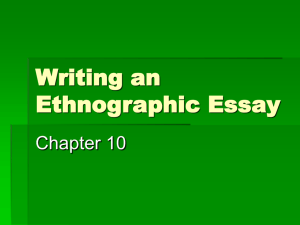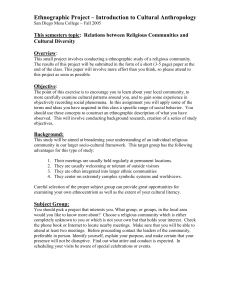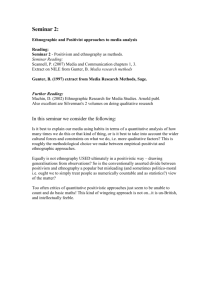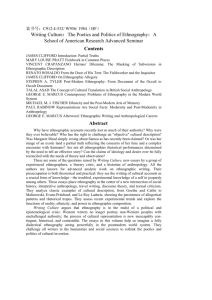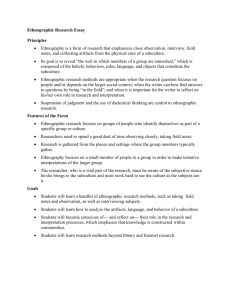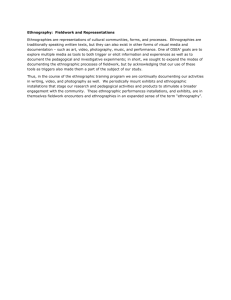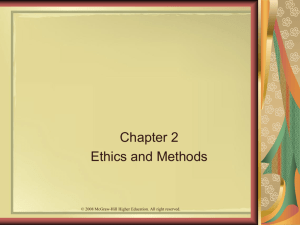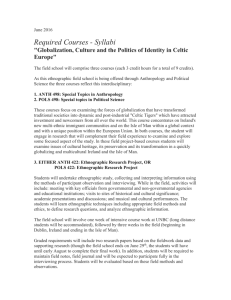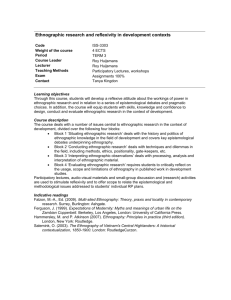A Quick and Dirty Introduction to the Spradley
advertisement
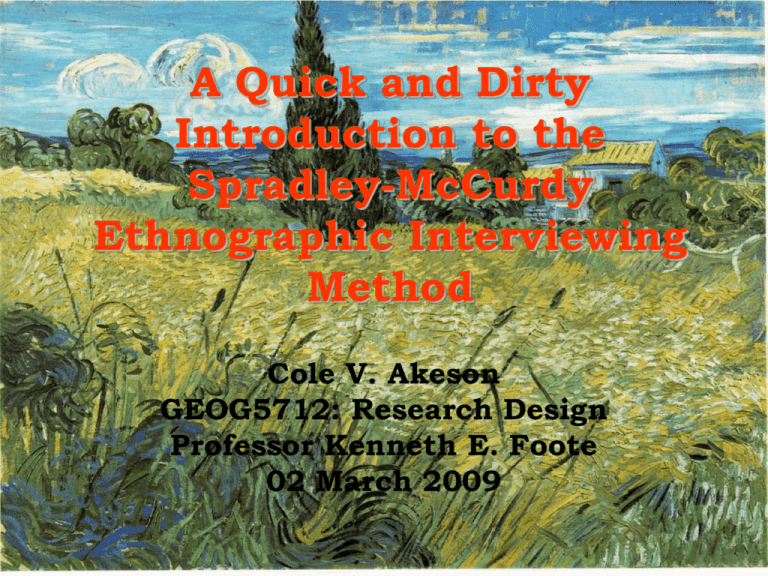
A Quick and Dirty Introduction to the Spradley-McCurdy Ethnographic Interviewing Method Cole V. Akeson GEOG5712: Research Design Professor Kenneth E. Foote 02 March 2009 Agenda • What is this mouthful called the Spradley-McCurdy ethnographic interviewing method? • How and when is it useful? • How does it work? A 12 step program • Caveats: When is it not useful/applicable? • Comparisons to other methods What is this “S-M E I M”? • Ethnography as a non-linear process – (continual shuffling between selecting a problem, formulating hypotheses, collecting data, analysis, writing up) • Informants’ knowledge is emphasized • A search for meaning through symbols, i.e. words and verbal cues, to tacit cultural knowledge • Moreover, focusing on ethnosemantic symbols – the symbol, meaning, and relationship between symbol and referent – Quoting sociological review: “Drunks are notorious liars and manipulators. Spradley unfortunately takes the lies as facts and bases his conclusions on them” (Spradley 1979, 49). • Finally, an interviewing methodology meant to systematize methodology for novice and expert alike Key ethnosemantic relationships • Domains: Connections of cultural symbols/folk terms into interrelated “domain” • Domain analysis (taxonomies): Internal structures of domains demonstrating differentiation among components • Componential analysis (paradigms): Search for differentiating attributes among symbols • Theme analysis: Relating domains in larger cultural processes How and when is the method useful? • Designed for use by: – Novices and experienced academics – Students, social scientists and non-academic professionals • Allowing ethnography to bridge interdisciplinary divides • “Grounded theory” approaches • Can also be adapted to theoretically bound, structured settings • Used and adapted by social scientists, police, journalists, salespeople, etc. Caveats and criticisms: When is it not useful/applicable? • Best for open-ended approaches • Less useful in shorter-term ethnographic investigations • Criticized by more humanistic ethnographers, social theory devotees • Earlier renditions critiqued as not considering positionality, etc. – Some terms en vogue during publishing of The Ethnographic Interview and The Cultural Experience are less often used today A 12 step program (no, not that one) 1. Locating an informant 2. Interviewing an informant 3. Making an ethnographic record 4. Asking descriptive questions 5. Analyzing ethnographic interviews 6. Making a domain analysis 7. Asking structural questions 8. Making a taxonomic analysis 9. Asking contrast questions 10.Making a componential analysis 11.Discovering cultural themes 12.Writing an ethnography A 12 step program (still not that one) 1. Locating an informant 2. Interviewing an informant 3. Making an ethnographic record 4. Asking descriptive questions 5. Analyzing ethnographic interviews 6. Making a domain analysis 7. Asking structural questions 8. Making a taxonomic analysis 9. Asking contrast questions 10.Making a componential analysis 11.Discovering cultural themes 12.Writing an ethnography Making ethnographic records • Utilize both field notes and transcriptions from recordings • Condensed notes, expanded notes (i.e. transcription together with field notes), journaling • Analysis and interpretation (i.e. coding) – By hand, by computer Descriptive Questions • Building rapport – “Apprehension→Exploration→ Cooperation→Participation” (Spradley 1979, 79) • Avoid leading questions • Types of questions: – Grand tour: broad sweeping explanations of space, time, events, people, activities, objects • “Typical,” recent time, show a process – – – – Mini-tour: refining explanation of smaller processes Example Experiences Native-language • Direct, hypothetical, typical sentence Domain analysis • Folk terms elicit important cultural symbols • These symbols are semantically interconnected in larger processes, “domains” – i.e. spatial, cause-effect, rationale, location of action, functional, sequential relationships • Next step: Determining not only presence, but meaning of relationship Structural questions and taxonomies • Elicit informants’ structural relationships within domains, avoid researchers’ perceived meaning • Used concurrently, repetitively, contextually, with descriptive questions (again, non-linear process) • Types: – Verification questions – Cover term questions: Elicit meaning of term and its subcomponents – Inferential included term questions – Card sorting questions • Create taxonomic relationships among terms: Relate terms hierarchically and functionally along one-dimensional relationship Example: “Taxonomy” Contrast questions and componential analysis • Elicit further details of relationships: comparative/contrasting uses • Types: – Contrast verification, directed contrast (list), dyadic (non-leading) contrast questions, triadic • Demonstrating multiple semantic differences (as opposed to taxonomies’ one) between folk terms, producing componential analyses or “paradigms” Example: “Paradigm” Themes and writing • Elicited from informants, but will be most influenced by the ethnographer • Typically multiple themes will be found in any research setting/microculture • Creating cultural inventories to draw forth themes – Looking for connections, but also gaps • Applying componential analysis on a larger scale, across data collected References • Further reading: McCurdy, David W., James P. Spradley, and Dianna J. Shandy. 2005. The cultural experience: Ethnography in complex society. Long Grove, IL: Waveland Press. 2nd ed. Spradley, James P. 1979. The ethnographic interview. New York: Harcourt College Publishers. Spradley, James P. and David W. McCurdy. 1972. The cultural experience: Ethnography in complex society. Long Grove, IL: Waveland Press. 1st ed. • Cover image Vincent van Gogh, Green Wheat Field, 1889, Kunsthaus Zurich. http://www.ibiblio.org/wm/paint/auth/gogh/fields/ (accessed March 1, 2009).
